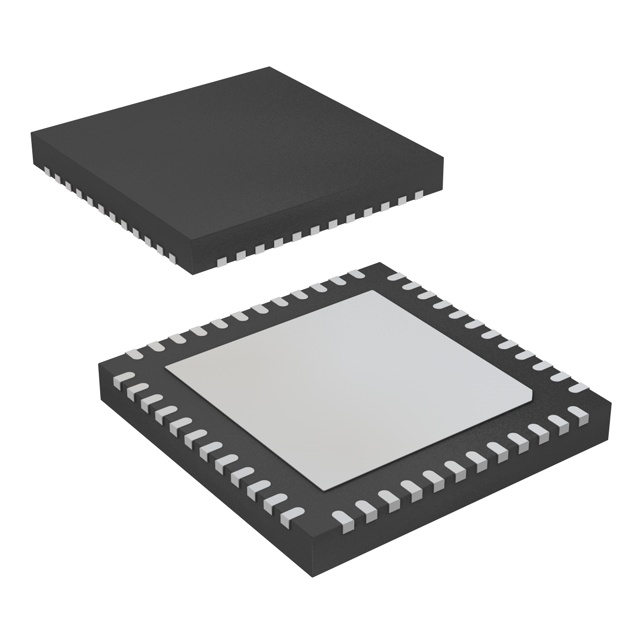
CDCLVP1216RGZT
ActiveLOW JITTER, 2-INPUT SELECTABLE 1:16 UNIVERSAL-TO-LVPECL BUFFER 48-VQFN -40 TO 85
Deep-Dive with AI
Search across all available documentation for this part.

CDCLVP1216RGZT
ActiveLOW JITTER, 2-INPUT SELECTABLE 1:16 UNIVERSAL-TO-LVPECL BUFFER 48-VQFN -40 TO 85
Technical Specifications
Parameters and characteristics commom to parts in this series
| Specification | CDCLVP1216RGZT | CDCLVP1216 Series |
|---|---|---|
| Differential - Input:Output [custom] | True | True |
| Differential - Input:Output [custom] | True | True |
| Embedded | - | False |
| Frequency - Max [Max] | 2 GHz | 2 GHz |
| Function | - | Clock Buffer |
| Input | LVCMOS, LVTTL, LVPECL, LVDS | LVCMOS, LVTTL, LVPECL, LVDS |
| Mounting Type | Surface Mount | Surface Mount |
| Number of Circuits | 1 | 1 |
| Operating Temperature [Max] | 85 °C | 85 °C |
| Operating Temperature [Min] | -40 °C | -40 °C |
| Output | LVPECL | LVPECL |
| Package / Case | 48-VFQFN Exposed Pad | 48-VFQFN Exposed Pad |
| Ratio - Input:Output [custom] | 16 | 16 |
| Ratio - Input:Output [custom] | 2 | 2 |
| Supplied Contents | - | Board(s) |
| Supplier Device Package | 48-VQFN (7x7) | 48-VQFN (7x7) |
| Type | Multiplexer, Fanout Buffer (Distribution) | Multiplexer, Fanout Buffer (Distribution), Timing |
| Utilized IC / Part | - | CDCLVP1216 |
| Voltage - Supply [Max] | 3.6 V | 3.6 V |
| Voltage - Supply [Min] | 2.375 V | 2.375 V |
Pricing
Prices provided here are for design reference only. For realtime values and availability, please visit the distributors directly
| Distributor | Package | Quantity | $ | |
|---|---|---|---|---|
| DigiKey | N/A | 1 | $ 20.05 | |
| 10 | $ 16.01 | |||
| 25 | $ 14.99 | |||
| 100 | $ 13.88 | |||
| 250 | $ 13.35 | |||
| 500 | $ 13.03 | |||
| 750 | $ 12.87 | |||
| Digikey | Cut Tape (CT) | 1 | $ 19.99 | |
| 10 | $ 18.37 | |||
| 25 | $ 17.61 | |||
| 100 | $ 15.52 | |||
| Digi-Reel® | 1 | $ 19.99 | ||
| 10 | $ 18.37 | |||
| 25 | $ 17.61 | |||
| 100 | $ 15.52 | |||
| Tape & Reel (TR) | 250 | $ 14.75 | ||
| 500 | $ 13.80 | |||
| LCSC | N/A | 1 | $ 16.33 | |
| 10 | $ 15.67 | |||
| 30 | $ 14.51 | |||
| 100 | $ 13.50 | |||
| Mouser Electronics | N/A | 1 | $ 19.97 | |
| 10 | $ 15.93 | |||
| 25 | $ 14.93 | |||
| 100 | $ 13.83 | |||
| 250 | $ 13.03 | |||
| 500 | $ 12.72 | |||
| Texas Instruments | SMALL T&R | 1 | $ 15.65 | |
| 100 | $ 13.67 | |||
| 250 | $ 10.54 | |||
| 1000 | $ 9.43 | |||
CDCLVP1216 Series
Low jitter, 2-input selectable 1:16 universal-to-LVPECL buffer
| Part | Input | Voltage - Supply [Min] | Voltage - Supply [Max] | Ratio - Input:Output [custom] | Ratio - Input:Output [custom] | Mounting Type | Package / Case | Differential - Input:Output [custom] | Differential - Input:Output [custom] | Number of Circuits | Frequency - Max [Max] | Supplier Device Package | Output | Type | Operating Temperature [Min] | Operating Temperature [Max] | Function | Embedded | Supplied Contents | Utilized IC / Part |
|---|---|---|---|---|---|---|---|---|---|---|---|---|---|---|---|---|---|---|---|---|
Texas Instruments CDCLVP1216RGZR | LVCMOS, LVDS, LVPECL, LVTTL | 2.375 V | 3.6 V | 16 | 2 | Surface Mount | 48-VFQFN Exposed Pad | 1 | 2 GHz | 48-VQFN (7x7) | LVPECL | Fanout Buffer (Distribution), Multiplexer | -40 °C | 85 °C | ||||||
Texas Instruments CDCLVP1216RGZT | LVCMOS, LVDS, LVPECL, LVTTL | 2.375 V | 3.6 V | 16 | 2 | Surface Mount | 48-VFQFN Exposed Pad | 1 | 2 GHz | 48-VQFN (7x7) | LVPECL | Fanout Buffer (Distribution), Multiplexer | -40 °C | 85 °C | ||||||
Texas Instruments CDCLVP1216EVM | Timing | Clock Buffer | Board(s) | CDCLVP1216 |
Description
General part information
CDCLVP1216 Series
The CDCLVP1216 is a highly versatile, low additive jitter buffer that can generate 16 copies of LVPECL clock outputs from one of two selectable LVPECL, LVDS, or LVCMOS inputs for a variety of communication applications. It has a maximum clock frequency up to 2 GHz. The CDCLVP1216 features an on-chip multiplexer (MUX) for selecting one of two inputs that can be easily configured solely through a control pin. The overall additive jitter performance is less than 0.1 ps, RMS from 10 kHz to 20 MHz, and overall output skew is as low as 30 ps, making the device a perfect choice for use in demanding applications.
The CDCLVP1216 clock buffer distributes one of two selectable clock inputs (IN0, IN1) to 16 pairs of differential LVPECL clock outputs (OUT0, OUT15) with minimum skew for clock distribution. The CDCLVP1216 can accept two clock sources into an input multiplexer. The inputs can be LVPECL, LVDS, or LVCMOS/LVTTL.
The CDCLVP1216 is specifically designed for driving 50-Ω transmission lines. When driving the inputs in single-ended mode, the LVPECL bias voltage (VAC_REF) should be applied to the unused negative input pin. However, for high-speed performance up to 2 GHz, differential mode is strongly recommended.
Documents
Technical documentation and resources


